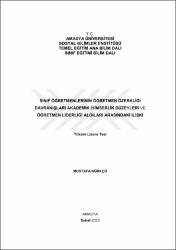Sınıf öğretmenlerinin öğretmen özerkliği davranışları akademik iyimserlik düzeyleri ve öğretmen liderliği algıları arasındaki ilişki
Özet
Bu araştırmada sınıf öğretmenlerinin; öğretmen özerkliği davranışları, akademik iyimserlik düzeyleri ve öğretmen liderliği rollerine yönelik algıları arasındaki ilişkilerin düzeylerini belirlemek amaçlanmıştır. Araştırmanın alt amaçlarında ise sınıf öğretmenlerinin; öğretmen özerkliği davranışlarında, akademik iyimserlik düzeylerinde ve öğretmen liderliği rollerine yönelik algılarında "cinsiyet, yaş, kurumdaki hizmet süresi, toplam hizmet süresi, okuldaki öğretmen ve öğrenci sayısı" değişkenlerinin etkisi incelenmiştir. Araştırma, nicel araştırma yönteminin ilişkisel tarama deseniyle yürütülmüştür. Araştırmanın evrenini, 2017-2018 eğitim öğretim yılında Tokat ili sınırları içerisindeki ilkokullarda görev yapan 1535 sınıf öğretmeni; örneklemini ise bu evren içerisinden oransız kümelere ayırma yoluyla örneklem seçim yöntemi kullanılarak seçilen 518 sınıf öğretmeni oluşturmuştur. Veri toplama aracı olarak Çolak (2016) tarafından geliştirilen "Öğretmen Özerkliği Ölçeği", Çoban ve Demirtaş (2011) tarafından geliştirilen "Okul Akademik İyimserlik Ölçeği" ve Beycioğlu (2009) tarafından geliştirilen "Öğretmen Liderliğine İlişkin Algı ve Beklenti Belirleme Ölçeği" kullanılmıştır. Toplanan veriler SPSS programında frekans, yüzde, aritmetik ortalama, standart sapma, t-testi, tek yönlü varyans analizi (ANOVA) ve basit korelasyon (Pearson Correlation) katsayısı değerleri kullanılarak analiz edilmiştir. Kişisel bilgilerin betimlenmesinde frekans ve yüzdeden, guruplar arasındaki farkın incelenmesinde ise aritmetik ortalama ve standart sapma değerlerinden yararlanılmıştır. Sınıf öğretmenlerinin öğretmen özerkliği, akademik iyimserlik ve öğretmen liderliği düzeylerinin öğretmenlerin cinsiyetine göre farklılaşıp farklılaşmadığının belirlenmesi için t-testi; öğretmenlerin yaşına, kurumdaki hizmet süresine, toplam hizmet süresine, okuldaki öğretmen ve öğrenci sayısına göre farklılaşıp farklılaşmadığının belirlenmesi için de tek yönlü varyans analizi (ANOVA) uygulanmıştır. Anlamlı farklılığın gözlemlendiği durumlarda farkın hangi gruplar arasında olduğunu görmek için Scheffe testi yapılmıştır. Sınıf öğretmenlerinin öğretmen özerkliği, akademik iyimserlik ve öğretmen liderliği düzeyleri arasındaki ilişkileri belirlemek için de korelasyon (Pearson Correlation) katsayısı kullanılmıştır. Araştırmanın sonuçlarına göre; sınıf öğretmenlerinin öğretmen özerkliği davranışlarının, akademik iyimserlik düzeylerinin ve öğretmen liderliği algılarının genel toplamları ve alt boyutları arasında düşük düzeyde, pozitif ve anlamlı bir ilişki olduğu görülmüştür. Sınıf öğretmenlerinin özerklik davranışları cinsiyet, yaş ve toplam hizmet süresi değişkenleri açısından özerkliğin boyutlarında veya toplamında anlamlı farklılık göstermiştir. Ancak kurumdaki hizmet süresi, okuldaki öğretmen sayısı ve öğrenci sayısı değişkenleri açısından özerkliğin boyutlarında ve toplamında anlamlı farklılık göstermemiştir. Sınıf öğretmenlerinin akademik iyimserlik düzeyleri cinsiyet değişkenine göre anlamlı farklılık göstermiştir. Ancak yaş, kurumdaki hizmet süresi, toplam hizmet süresi, okuldaki öğretmen ve öğrenci sayısı değişkenlerine göre akademik iyimserliğin toplamında ve boyutlarında anlamlı farklılık göstermemiştir. Sınıf öğretmenlerinin öğretmen liderliği algı düzeyleri cinsiyet değişkenine göre kurumsal gelişme alt boyutunda anlamlı farklılık göstermiştir. Ancak yaş, kurumdaki hizmet süresi, toplam hizmet süresi, okuldaki öğretmen ve öğrenci sayısı değişkenlerine göre öğretmen liderliği toplamında ve boyutlarında anlamlı farklılık göstermemiştir. The aim of this study is to determine the levels of relationships between teacher autonomy behaviors, academic optimism levels and perceptions of teacher leadership roles. In the sub-objectives of the research; the effects of gender, age, length of service in the institution, total service duration, number of teachers and students in the school were examined in the perceptions of teacher autonomy, academic optimism levels and teacher leadership roles. The research was carried out with relational screening design, which is one of the quantitative research methods. The population of the study consists of 1535 class teachers who work in primary schools within the borders of Tokat province in the 2017-2018 academic years. The sample of the study was composed of 518 classroom teachers, who were selected using the sampling selection method, by disproportionate clustering. As the data collection tools; Teacher Autonomy Scale developed by Çolak (2016), the School Academic Optimism Scale developed by Çoban and Demirtaş (2011) and the Perception and Expectancy Determination Scale about Teacher Leadership developed by Beycioğlu (2009) were used. Data were analyzed by using frequency, percentage, arithmetic mean, standard deviation, t-test, one way variance analysis (ANOVA) and simple correlation (Pearson Correlation) coefficient. Frequency / percentage in describing personal information; Arithmetic mean and standard deviation values were used to examine the difference between the groups. autonomy, academic optimism and teacher leadership levels differ according to the gender of teachers; One-way analysis of variance (ANOVA) was applied to determine whether the teachers differ according to their age, length of service in the institution, total service duration, and the number of teachers and students in the school. In cases where significant difference was observed, Scheffe test was performed to see the difference between groups. Pearson Correlation coefficient was used to determine the relationship between teacher autonomy, academic optimism and teacher leadership levels. Pearson Correlation coefficient was used to determine the relationship between teacher autonomy, academic optimism and teacher leadership levels. According to the results of the study; It was observed that there was a low, positive and significant relationship between the teachers' autonomy behaviors, academic optimism levels and teacher leadership perceptions. The autonomy of classroom teachers showed significant differences in the dimensions or the totality of autonomy in terms of gender, age, length of service in the institution and total length of service. However, there were no significant differences in sub-scales and the total of autonomy in terms of the number of teachers and the number of students in the school and length of service in the institution and total length of service. The level of academic optimism of the classroom teachers showed a significant difference according to the gender variable. However, there were no significant differences in the total and dimensions of academic optimism in terms of age, length of service in the institution, total length of service, number of teachers and students in the school. The level of teacher leadership perception of the classroom teachers showed a significant difference in the institutional development sub-dimension according to the gender variable. However, there was no significant difference in the total and dimensions of teacher leadership according to age, length of service in the institution, total duration of service, number of teachers and students in the school.
Bağlantı
https://tez.yok.gov.tr/UlusalTezMerkezi/TezGoster?key=T1mWGp9MngYYkCSgiJvtVigDDDbu1VeqRSUbusANjDjnDmXl9HaNfwth-Wk0vTuXhttps://hdl.handle.net/20.500.12450/1931
Koleksiyonlar
- Tez Koleksiyonu [318]


















